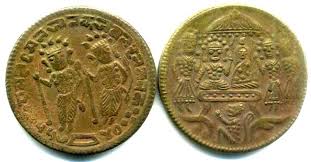The origins of coinage in ancient India trace back to a significant period that has intrigued historians and archaeologists alike. While substantial evidence suggests that the first coins were minted just before the 5th century B.C. in northern and central India, some historians argue for an earlier inception, possibly as far back as the 8th century B.C. This contention, however, remains disputed among historians. The evidence primarily indicates that the establishment of coinage in India blossomed between the 5th and 6th centuries B.C., marking a critical juncture in the region's economic and cultural history.
The Early Beginnings of Coinage in India
One of the earliest mentions of coins in Indian literature can be found in Panini's Ashtadhyayi, composed in the 4th or 5th century B.C. Panini refers to various forms of currency, including terms like Satamana, Nishka, Sana, Vimastika, and Karshapana. These references underscore the notion that coinage was not only a reality but a recognized aspect of economic transactions in ancient Indian society by around 500 B.C.
This period also saw the availability of silver—a metal that was scarce during the Vedic era (pre-600 B.C.)—indicating a shift in metallurgical resources. Historians believe that the influx of silver into India arose from international trade connections, notably with regions such as Afghanistan and Persia, which would have facilitated the minting of coins.
The Coinage of the Indo-Greeks and Other Dynasties
The landscape of ancient Indian coinage was profoundly influenced by external forces, particularly those stemming from Hellenistic traditions. The Indo-Greeks, who ruled parts of northern India after Alexander the Great's conquests, minted coins that were adorned with Greek deities, cultural symbols, and the portraits of their rulers. These silver coins, characterized by their intricate designs and inscriptions, provide key insights into the socio-political dynamics of the era.
Remarkably, the historical narrative of the Indo-Greeks has been largely reconstructed through the study of their coins, which serve as primary sources for understanding their influence and interactions within the Indian subcontinent. The coexistence of diverse cultures during this period is exemplified by the minting practices adopted by the subsequent Saka-Pahlavas and Kushanas, dated between the 2nd century B.C. and the 2nd century A.D.
The Saka coinages represent some of the earliest dated coins in Indian history, often inscribed with dates corresponding to the Saka era, which started in A.D. 78. The significance of the Saka era extends beyond numismatics; it later became the official calendar of the Indian Republic, highlighting the enduring legacy of these ancient monetary systems.
Trade Networks and Cultural Exchange
The discovery of various foreign coin hoards throughout India has been instrumental in illuminating the complex trade networks that flourished during ancient times. India engaged in extensive commerce with regions such as the Middle East, Europe (notably Greece and Rome), and China, facilitated by both land routes (like the Silk Route) and maritime trade. The richness of these interactions not only reflects economic exchanges but also the cultural and intellectual transfers that occurred.
By the time of the Roman historian Pliny, trade between India and Rome had reached unprecedented heights, leading to significant economic implications for the Roman Empire. The Romans imported a variety of goods from India, which created a balance of payments dilemma. In southern India, Roman coins circulated widely, sometimes altered to signify resanction from foreign dominance. This practice reflects the intricate relationships between coinage, economy, and cultural identity.
The Transition to Medieval Coinage
As ancient Indian coins began to dwindle, transitioning into the era of medieval coinage, a diverse array of coins emerged. Each coin, reflective of its issuing authority and societal values, showcased the artistic and technological advancements of its time. The meticulous craftsmanship displayed in ancient coins highlights the skills and sophistication of coin makers throughout different dynasties.
These coins not only served as a medium of exchange but were also potent symbols of authority and power. They provided a sense of identity for various communities and signified the political aspirations of rulers. The transition from ancient to medieval coinage was characterized by a fusion of regional styles and techniques, culminating in a rich tapestry of numismatic heritage.
Conclusion
The history of ancient coinage in India is a profound narrative of economic evolution, cultural exchange, and artistic achievement. From the early days of minted coins in the 5th century B.C. to the intricate designs of the Indo-Greek period, these coins serve as invaluable links to our past. They narrate stories of trade, social structure, and political power, ultimately laying the foundation for the complexities of modern India’s economy and culture.
As we explore the ancient cities and the heritage embedded in their coins, we gain a deeper appreciation for the historical significance of these artifacts. Understanding this evolution is not just about recognizing a medium of exchange; it is about grasping the very fabric of human civilization in ancient India a testament to the ingenuity and resilience of its people.
